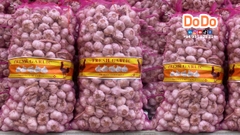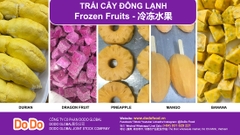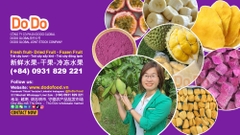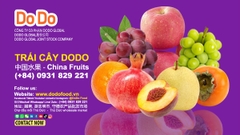
Vietnam's Rising Durian Export Industry
Overview: A Meteoric Rise
Vietnam has rapidly become a world leader in durian exports, primarily driven by official access to the massive Chinese market. Since China officially approved the import of Vietnamese durians in July 2022, exports have skyrocketed, making durian one of Vietnam's top agricultural exports by value.
1. Key Export Markets
China (The Dominant Market): Over 90% of Vietnam's durian exports go to China. The shift from informal "gray channel" cross-border trade to official exports with signed protocols has been the single biggest factor in the industry's growth. This ensures higher quality, better prices, and traceability.
Other Markets: While much smaller in volume, Vietnam also exports durians to:
- Thailand: Interestingly, Thailand both exports and imports durians. They often import Vietnamese durians for re-export or processing when their own supply is low.
- Australia, USA, Canada, EU, Japan, South Korea: These are high-value markets with strict phytosanitary requirements. Exports to these countries are growing as Vietnamese producers meet the necessary standards (e.g., irradiation treatment for the US market).
2. Major Durian Varieties for Export
Vietnam grows several durian varieties, but a few dominate the export trade due to their quality, yield, and market preference:
Ri6 : The king of Vietnamese exports. This variety is highly prized for its thick, creamy, sweet, and minimally fibrous flesh, small seeds, and low odor. It's well-suited for long-distance transport and is the favorite of the Chinese market.
Musang King (Mao Shan Wang): A highly sought-after premium variety known for its rich, bitter-sweet flavor and distinctive orange-yellow flesh. While less exported in volume than Ri6 due to higher cost and lower yield, it commands a very high price.
Dona (Monthong): Recognizable by its elongated, green-spiked shape. It has a sweet, slightly bitter taste and a firm texture.
3. Why Vietnam is So Successful

Several factors have contributed to the boom:
Favorable Geography and Climate: The Central Highlands (provinces like Dak Lak, Dak Nong, Gia Lai) and the Mekong Delta (Tien Giang, Ben Tre, Vinh Long) offer ideal conditions for durian cultivation.
Official Market Access to China: The signed protocol with China was a game-changer, legitimizing and stabilizing the trade.
Competitive Price: Vietnamese durians are often more competitively priced than those from Thailand or Malaysia, making them attractive to buyers.
Investment in Farming and Technology: Farmers are increasingly adopting Good Agricultural Practices (GAP), using technology for pest management, and investing in modern packaging and preservation techniques to meet international standards.
Year-Round Harvest: Through techniques like using light to induce flowering, farmers can produce durians outside the main season (which is May-September), allowing for more consistent supply.
4. Economic Impact
Export Value: Durian exports have shattered records. In 2023, Vietnam's durian export value reached $2.2 billion, a massive increase of over 400% from the previous year. For 2024, projections are even higher, with estimates of reaching $3.5 billion.
Farmer Incomes: The durian boom has significantly increased incomes for farmers, transforming the economies of major growing regions. A hectare of durian can generate tens of thousands of dollars in profit.
Investment and Development: The high returns have led to massive investment in expanding durian farming areas, though this raises concerns about land use and sustainability.
5. Challenges and Future Outlook

The industry faces several challenges it must navigate to sustain growth:
Over-Reliance on a Single Market (China): Dependence on China makes the industry vulnerable to any changes in Chinese policy, economic conditions, or border regulations.
Quality Control and Food Safety: Maintaining consistent quality and adhering to strict Maximum Residue Limits (MRLs) for pesticides is crucial. Any major food safety scandal could damage the brand.
Disease Management: Diseases like Phytophthora (root rot) can devastate durian orchards. Sustainable farming practices are essential for long-term health.
Land and Sustainability: Rapid expansion can lead to deforestation, water resource depletion, and conversion of land from other essential crops.
Increasing Competition: Thailand remains the world's top exporter and is a formidable competitor. Malaysia is also seeking official access to export its whole frozen durians to China.
Future Outlook: The future is bright but requires strategic planning. The key goals for Vietnam are:
Market Diversification: Increasing exports to demanding markets like the US, EU, and Japan to reduce reliance on China.
Brand Building: Establishing "Vietnamese Durian" as a premium, high-quality, and safe product on the global stage.
Value Addition: Developing more processed durian products (paste, frozen pulp, powder, confe.
...........
DODO Global 股份公司在越南专业做进出口, 批发公司:洋葱,大蒜, 土豆, 胡萝卜, 蔬菜.
DODO在农业市场上拥有强大的影响力,为国内外买家提供高质量的大蒜、洋葱、土豆、生姜、辣椒、胡萝卜、蔬菜和水果,确保价格竞争力强且来源可靠,并出口越南农产品。
我们在网站、Facebook、YouTube、Tiktok、Instagram、LinkedIn 等平台上拥有营销系统,
拥有超过 200 万粉丝。我们在网站, 电子商务 卖产品
- 采购与贸易:与农民和全球供应商合作,提供优质产品
...........
Công ty cổ phần DoDo Global một trong những đơn vị chuyên về xuất nhập khẩu, phân phối và mua bán hành tây, tỏi , rau củ quả tại Việt Nam. Với nhiều năm kinh nghiệm trong lĩnh vực nông sản, đặc biệt là (tỏi và hành tây, gừng, ớt, khoai tây, cà rốt...) DODO đã khẳng định vị thế của mình trên thị trường trong nước và quốc tế.
DODO chia sẻ những sản phẩm tốt nhất, giá cả tốt nhất và phục vụ tốt nhất tới khách hàng.
Hiện tại DODO đã có hơn 2 triệu người theo dõi DODO trên các mạng xã hội như:
Facebook, Youtube, Tiktok, Instagarm, Linhkedin... để tất cả mọi người để tìm kiếm DODO.
...........
DODO Global Joint Stock Company is a reputable company specialising in importing, exporting, wholesale, and distributing vegetables and fruits. With a strong presence
in the agricultural market, DODO supplies high-quality Vegetables(garlic, onions, potatoes, ginger, chilli, carrot...) and fruit for domestic and international buyers,
ensuring competitive prices and reliable sourcing. and export Vietnam Agriculture.is a reputable company specialising in importing, exporting, wholesale, and distributing vegetables and fruits. With a strong presence
in the agricultural market, DODO supplies high-quality Vegetables(garlic, onions, potatoes, ginger, chilli, carrot...) and fruit for domestic and international buyers,
ensuring competitive prices and reliable sourcing. and export Vietnam Agriculture.
If you want to talk business? Let's connect/联系/ Liên hệ:
Wechat/ Whatsapp/ Line/ Viber/ Kakao talk: +84 0931 829 221
Email: dodofoods.vn@gmail.com
............................
Follow us on/ 关注我们/ Theo dõi chúng tôi:
Website: https: https://dodofood.vn/
Tiktok : https://www.tiktok.com/@dodoglobalfood
https://www.tiktok.com/@greenhousesg
YouTube: https://www.youtube.com/@DodoGlobal
Instagram: https://www.instagram.com/dodoglobalfood
https://www.instagram.com/greenfarmforum
Facebook: https://www.facebook.com/DoDoGlobalFood/
LinkedIn: https://www.linkedin.com/company/dodo-food/
https://www.linkedin.com/company/green-farm-forum/






